Country United States | Type Infantry | |
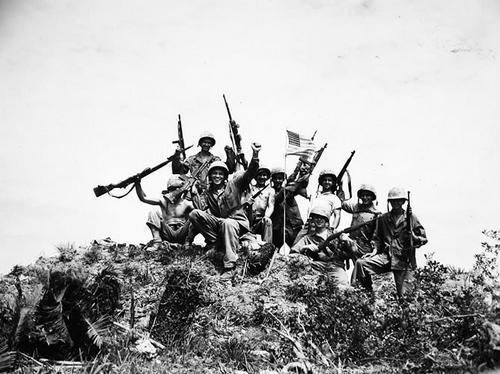 | ||
Active 7 September 1944 – 1 April 1946 Role Locate close with and destroy the enemy by fire and maneuver Nickname(s) The Striking Sixth or New Breed | ||
The 6th Marine Division was a United States Marine Corps World War II infantry division formed in September 1944. During the invasion of Okinawa it saw combat at Yae-Take and Sugar Loaf Hill and was awarded a Presidential Unit Citation. The 6th Division had also prepared for the invasion of Japan before the war ended. After the war it served in Tsingtao, China where the division was disbanded on April 1, 1946, being the only Marine division to be formed and disbanded overseas and never set foot in the United States.
Contents
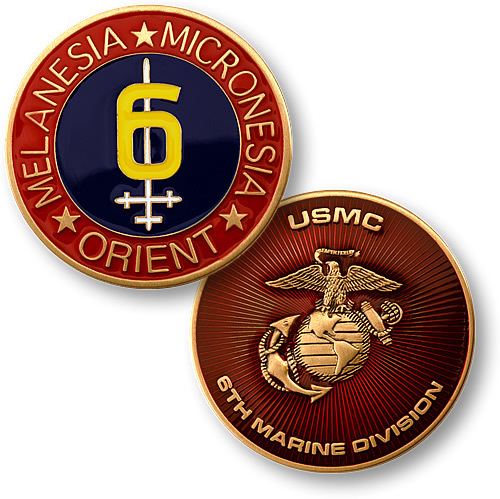
Formation on the Solomon Islands
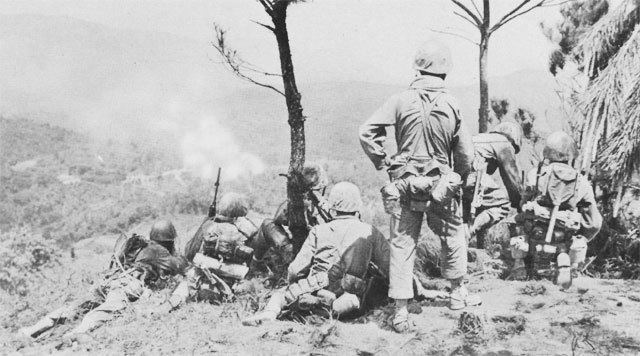
The 6th Marine Division was formed on Guadalcanal in the southern Solomon Islands on September 7, 1944. The 6th division was formed from three infantry regiments, the 4th, 22nd and 29th Marines, and other units such as Engineer, Medical, Pioneer, Motor Transport, Tank, Headquarters, and Service battalions. The core cadre around which the division was formed was the former 1st Provisional Marine Brigade, which included the 4th and 22nd Marine Regiments, plus their supporting artillery battalions - these artillery battalions were later consolidated into the 15th Marine Regiment.

The Battle of Guam ended in August 1944 and the 1st Provisional Marine Brigade was called to Guadalcanal along with the 1st Battalion, 29th Marines, which had served with the 2nd Marine Division in the Battle of Saipan on the Mariana Islands. With a core of all these veterans incorporated into the new division, the 6th was not considered "green" despite being a new formation- most of the men were veterans of at least one campaign and many were serving a second combat tour, half the forces in the 3 Infantry Regiments were all veterans, and some units were even 70% veterans. The 2nd and 3rd Battalions, 29th Marines disembarked from the United States on 1 August 1944, and landed on Guadalcanal on 7 September 1944 to further stand-up the Division. The now fully manned 6th division underwent "rugged" training on Guadalcanal between October and January before it was shipped 6,000 miles to land as part of the III Amphibious Corps on the island of Okinawa on 1 April 1945.
Okinawa
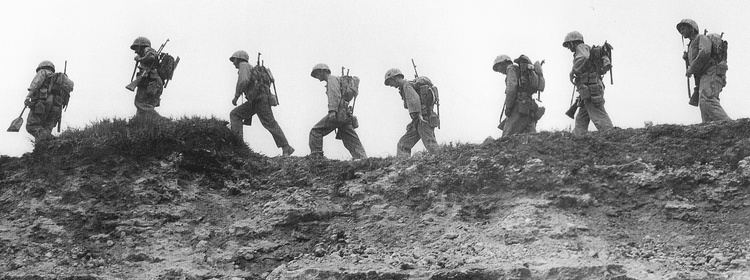
The Division's initial objectives in the amphibious landing was the capture of Yontan Airfield while protecting the left (North) Flank. Despite a Japanese battalion in their zone the Division met only light resistance and by the 3rd day was approaching Iskhikawa, twelve days ahead of schedule. By 14 April, the division had swept all through the northern Ishikawa Isthmus – 55 miles from the original landings. The division's rapid advance continued until eventually they encountered prepared and dug-in defenders at Yae-Take, where the majority of the Udo Force was entrenched. The Udo Force, or Kunigami Detachment, under Colonel Takehiko Udo was built around the 2d Infantry Unit of the 44th Independent Mixed Brigade – reinforced by having absorbed both former sea-raiding suicide squadrons and remnants of the Battalion earlier destroyed by the 6th – was responsible for defense of the Motobu Peninsula and Ie Shima. The 6th Division's drive captured most of northern Okinawa and the Division won praise for its fast campaign – Brigadier General Oliver P. Smith wrote: "The campaign in the north should dispel the belief held by some that Marines are beach-bound and are not capable of rapid movement."
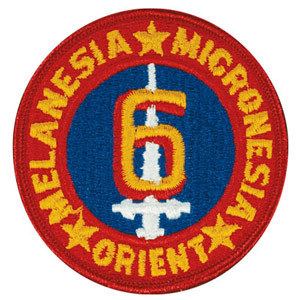
After heavy fighting in the south, the division was ordered to replace the Army 27th Infantry Division on the western flank. The 6th division advanced south to partake in the assault against the strong Japanese defense line, called the Shuri Line, that had been constructed across the southern coastline. The Shuri Line was located in hills that were honeycombed with caves and passages, and the Marines had to traverse the hills to cross the line. The division was ordered to capture the Sugar Loaf Hill Complex, 3 hills which formed the western anchor of the Shuri Line defense. The Marines that had assaulted the line were attacked by heavy Japanese mortar and artillery fire, which made it more difficult to secure the line. After a week of fighting, the hill had been taken.
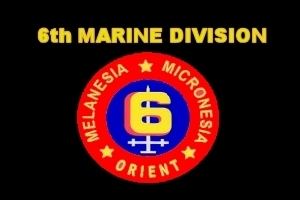
After Sugarloaf the Division advanced through Naha, conducted a shore-to-shore amphibious assault on, and subsequent 10-day battle to capture, the Oroku peninsula (defended by Admiral Ōta's forces), and partook in mop-up operations in the south. The battle on Okinawa ended on 21 June 1945. The Sixth division was credited with over 23,839 enemy soldiers killed or captured, and with helping to capture 2⁄3 of the island, but at the cost of heavy casualties, including 576 casualties on one day (May 16) alone, – a day described as the "bitterest" fighting of the Okinawa campaign where "the regiments had attacked with all the effort at their command and had been unsuccessful".
For its actions at Okinawa, the 6th Marine Division (and reinforcing units) earned a Presidential Unit Citation. The citation reads:
For extraordinary heroism in action against enemy Japanese forces during the assault and capture of Okinawa, April 1 to June 21, 1945. Seizing Yontan Airfield in its initial operation, the SIXTH Marine Division, Reinforced, smashed through organized resistance to capture Ishikawa Isthmus, the town of Nago and heavily fortified Motobu Peninsula in 13 days. Later committed to the southern front, units of the Division withstood overwhelming artillery and mortar barrages, repulsed furious counterattacks and staunchly pushed over the rocky terrain to reduce almost impregnable defenses and capture Sugar Loaf Hill. Turning southeast, they took the capital city of Naha and executed surprise shore-to-shore landings on Oroku Peninsula, securing the area with its prized Naha Airfield and Harbor after nine days of fierce fighting. Reentering the lines in the south, SIXTH Division Marines sought out enemy forces entrenched in a series of rocky ridges extending to the southern tip of the island, advancing relentlessly and rendering decisive support until the last remnants of enemy opposition were exterminated and the island secured. By their valor and tenacity, the officers and men of the SIXTH Marine Division, Reinforced contributed materially to the conquest of Okinawa, and their gallantry in overcoming a fanatic enemy in the face of extraordinary danger and difficulty adds new luster to Marine Corps history, and to the traditions of the United States Naval Service.
Guam and China
In July 1945, the 6th division was withdrawn from Okinawa to the island of Guam to prepare for Operation Coronet, the planned invasion of Honshū, Japan that was supposed to occur in April 1946 but the Japanese surrenderd in August 1945. While the 4th Marines were sent for brief occupation duty in Japan, the rest of the 6th spent September in Guam preparing for duty in China
The division arrived in Tsingtao, China on 11 October 1945 where it remained until it was disbanded on April 1, 1946, being replaced by the 3d Marine Brigade. In its time at Tsingtao the division not only accepted the surrender of local Japanese forces (on Oct 25) but also oversaw their subsequent repatriation to Japan; prevented the communists from attacking the surrendered Japanese forces and dissuaded communist forces from advancing on the city, restored and maintained order, and came to be seen as the protector of minority groups in the former German concession.
Commanders
The 6th Division had 2 commanders during its short existence:
The Assistant Division Commander was Brigadier General William T. Clement
Medal of Honor recipients
The Medal of Honor was awarded to five Marines and one Navy corpsman assigned to the 6th Marine Division during World War II:
